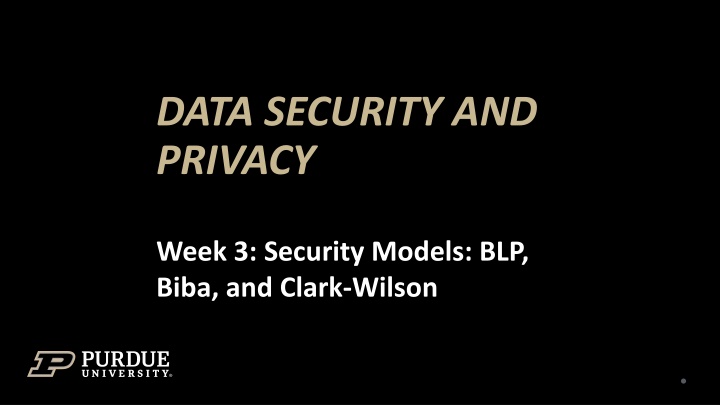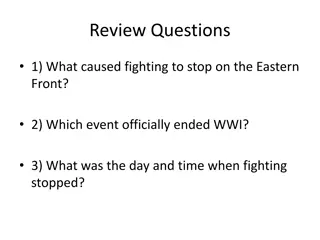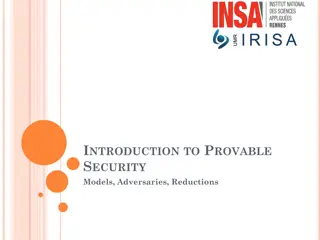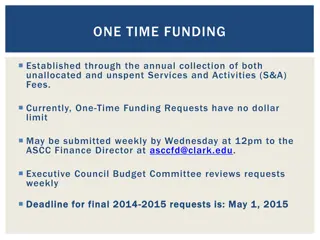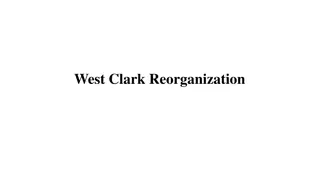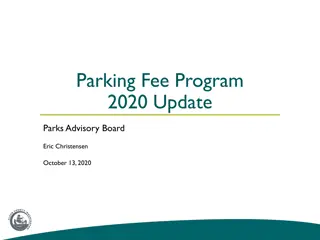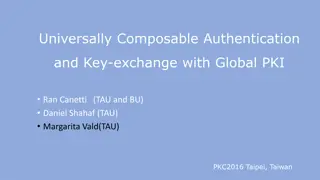Security Models: BLP, Biba, and Clark-Wilson
This lecture covers security models including Bell and La Padula, Biba, and Clark-Wilson. It discusses access control at different abstractions, multi-level security, and integrity considerations. The readings delve into computer security policies and models from the past.
Download Presentation

Please find below an Image/Link to download the presentation.
The content on the website is provided AS IS for your information and personal use only. It may not be sold, licensed, or shared on other websites without obtaining consent from the author.If you encounter any issues during the download, it is possible that the publisher has removed the file from their server.
You are allowed to download the files provided on this website for personal or commercial use, subject to the condition that they are used lawfully. All files are the property of their respective owners.
The content on the website is provided AS IS for your information and personal use only. It may not be sold, licensed, or shared on other websites without obtaining consent from the author.
E N D
Presentation Transcript
DATA SECURITY AND PRIVACY Week 3: Security Models: BLP, Biba, and Clark-Wilson 1
Readings for This Lecture Bell and La Padula: Secure Computer System: Unified Exposition and MULTICS Interpretation Section II Kenneth J. Biba: "Integrity Considerations for Secure Computer Systems", MTR-3153, The Mitre Corporation, April 1977. David D. Clark and David R. Wilson. A Comparison of Commercial and Military Computer Security Policies. In IEEE SSP 1987.
Related Readings for This Lecture Other Related Papers: David FC. Brewer and Michael J. Nash. The Chinese Wall Security Policy. in IEEE SSP 1989.
Outline Overview of the Bell Lapadula Model Details of the Bell Lapadula Model Analysis of the Bell Lapadula Model More on Multi-level Security TCSEC and Common Criteria Biba Integrity Models Clark-Wilson Model and Chinese Wall Policy
Access Control at Different Abstractions Using principals Determines which principals (user accounts) can access what documents Using subjects Determines which subjects (processes) can access what resources This is where BLP focuses on
Multi-Level Security (MLS) (1) There are security classifications or security levels Users/principals/subjects have security clearances Objects have security classifications Example of security levels Top Secret > Secret > Confidential > Unclassified Security goal (confidentiality): Ensures that information does not flow to those not cleared for that level
Multi-Level Security (MLS) (2) The capability of a computer system to carry information with different sensitivities (i.e. classified information at different security levels), permit simultaneous access by users with different security clearances and needs- to-know, and prevent users from obtaining access to information for which they lack authorization. Discretionary access control fails to achieve MLS Typically use Mandatory Access Control Primary Security Goal: Confidentiality
Mandatory Access Control Mandatory access controls (MAC) restrict the access of subjects to objects based on a system-wide policy denying users full control over the access to resources that they create. The system security policy (as set by the administrator) entirely determines the access rights granted
Bell-LaPadula Model: A MAC Model for Multi-level Security Introduce in 1973 Air Force was concerned with security in time-sharing systems Many OS bugs Accidental misuse Main Objective: Enable one to formally show that a computer system can securely process classified information
What is a Security Model? A model describes the system e.g., a high level specification or an abstract machine description of what the system does A security policy defines the security requirements for a given system Verification techniques that can be used to show that a policy is satisfied by a system System Model + Security Policy = Security Model
Approach of BLP Use state-transition systems to describe computer systems Define a system as secure iff. every reachable state satisfies 3 properties simple-security property, *-property, discretionary-security property Prove a Basic Security Theorem (BST) so that given the description of a system, one can prove that the system is secure
Outline Overview of the Bell Lapadula Model Details of the Bell Lapadula Model Analysis of the Bell Lapadula Model More on Multi-level Security TCSEC and Common Criteria Biba Integrity Models Clark-Wilson Model and Chinese Wall Policy
The BLP Security Model A computer system is modeled as a state-transition system There is a set of subjects; some are designated as trusted. Each state has objects, an access matrix, and the current access information. There are state transition rules describing how a system can go from one state to another Each subject s has a maximal sec level Lm(s), and a current sec level Lc(s) Each object has a classification level
Elements of the BLP Model Security levels, e.g.: {TS, S, C, U} Lm: Max Sec. Level Lc: Current Sec. Level L: Class. Level Objects Subjects Current Accesses Trusted Subjects Access Matrix
The BLP Security Policy A state is secure if it satisfies Simple Security Condition (no read up): S can read O iff Lm(S) L(O) The Star Property (no write down): for any S that is not trusted S can read O iff Lc(S) L(O) (no read up) S can write O iff Lc(S) L(O) (no write down) Discretionary-security property every access is allowed by the access matrix A system is secure if and only if every reachable state is secure.
Implication of the BLP Policy Objects Highest Can Write Max Level Subject Current Level Can Read & Write Can Read Lowest
STAR-PROPERTY Applies to subjects not to principals and users Users are trusted (must be trusted) not to disclose secret information outside of the computer system Subjects are not trusted because they may have Trojan Horses embedded in the code they execute Star-property prevents overt leakage of information and does not address the covert channel problem
Outline Overview of the Bell Lapadula Model Details of the Bell Lapadula Model Analysis of the Bell Lapadula Model More on Multi-level Security TCSEC and Common Criteria Biba Integrity Models Clark-Wilson Model and Chinese Wall Policy
Is BLP Notion of Security Good? The objective of BLP security is to ensure a subject cleared at a low level should never read information classified high The ss-property and the *-property are sufficient to stop such information flow at any given state. What about information flow across states?
BLP Security Is Not Sufficient! Consider a system with two subjects s1,s2 and two objects o1,o2 fS(s1) = fC(s1) = fO(o1) = high fS(s2) = fC(s2) = fO(o2) = low And the following execution s1 gets read access to o1, read something, release access, then change current level to low, get write access to o2, write to o2 Every state is secure, yet illegal information flow exists, assuming that a subject can store information from one state to the next Solution: tranquility principle: subject cannot change current levels, or cannot drop current level to below the highest level read so far
More on the BLP Notion of Security When a subject A copies information from high to a low object f, this violates the star-property, but no information leakage occurred yet Only when B, who is not cleared at high, reads f, does leakage occurs If the access matrix limits access to f only to A, then such leakage may never occur BLP notion of security is neither sufficient nor necessary to stop illegal information flow (through direct/overt channels) The state based approach is too low level and limited in expressive power
How to Fix The BLP Notion of Security (if we want to)? May need to differentiate externally visible objects from other objects e.g., a printer is different from a memory object State-sequence based property e.g., define security to mean that there exists no sequence of states so that there is an information path from a high object to a low externally visible object or to a low subject
The Basic Security Theorem This provides the verification techniques piece in Model Policy Verification framework Restatement of The Basic Security Theorem: A system is a secure system if and only if the starting state is a secure state and each action (concrete state transition that could occur in an execution sequence) of the system leads the system into a secure state.
Observations of the BST The BST is purely a result of defining security as a state-based property. It holds for any other state-based property The BST cannot be used to justify that the BLP notion of security is good This is McLean s main point in his papers A Comment on the Basic Security Theorem of Bell and LaPadula [1985] Reasoning About Security Models [1987] The Specification and Modeling of Computer Security [1990]
Main Contributions of BLP The overall methodology to show that a system is secure adopted in many later works The state-transition model which includes an access matrix, subject security levels, object levels, etc. The introduction of *-property ss-property is not enough to stop illegal information flow
Outline Overview of the Bell Lapadula Model Details of the Bell Lapadula Model Analysis of the Bell Lapadula Model More on Multi-level Security TCSEC and Common Criteria Biba Integrity Models Clark-Wilson Model and Chinese Wall Policy
Other Limitations with BLP Deal only with confidentiality, does not deal with integrity at all Confidentiality is often not as important as integrity in most situations Integrity is addressed by models such as Biba, Clark-Wilson, which we will cover later Does not deal with information flow through covert channels
Overt (Explicit) Channels vs. Covert Channels Security objective of MLS in general, BLP in particular, is high-classified information cannot flow to low-cleared users Illegal information flow via overt channels (e.g., read/write an object) is blocked by BLP Illegal information flow by covert channels can still occur communication channel based on the use of system resources not normally intended for communication between the subjects (processes) in the system
Examples of Covert Channels Using file lock as a shared boolean variable By varying its ratio of computing to input/output or its paging rate, the service can transmit information to a concurrently running process Timing of packets being sent In general, shared resources can be used as covert channels What is needed is one party can affect them, and another can observe the effects Covert channels are often noisy However, information theory and coding theory can be used to encode and decode information through noisy channels
More on Covert Channels Covert channels cannot be blocked by *-property It is generally very difficult, if not impossible, to block all covert channels One can try to limit the bandwidth of covert channels Military requires cryptographic components be implemented in hardware to avoid trojan horse leaking keys through covert channels Covert channels are achieved by collaboration or high and low subjects.
More on MLS: Security Levels Used as attributes of both subjects & objects clearance & classification Typical military security levels: top secret secret confidential unclassified Typical commercial security levels restricted proprietary sensitive public
Security Categories Also known as compartments Typical military security categories army, navy, air force nato, nasa, noforn Typical commercial security categories Sales, R&D, HR Dept A, Dept B, Dept C
Security Labels Labels = Levels P (Categories) P (Categories) is powerset (set of all subsets) of Categories There is a natural partial ordering relationship among Labels (e1, C1) (e2, C2) iff. e1 e2 and C1 C2 This ordering relation is a partial order reflexive, transitive, anti-symmetric e.g., All security labels form a lattice
An Example Security Lattice levels={top secret, secret} categories={army, navy} Top Secret, {army, navy} Top Secret, {army} Secret, {army, navy} Top Secret, {navy} Top Secret, {} Secret, {navy} Secret, {army} Secret, {}
The need-to-know principle Even if someone has all the necessary official approvals (such as a security clearance) to access certain information they should not be given access to such information unless they have a need to know: that is, unless access to the specific information necessary for the conduct of one's official duties. Can be implemented using categories and/or DAC
Outline Overview of the Bell Lapadula Model Details of the Bell Lapadula Model Analysis of the Bell Lapadula Model More on Multi-level Security TCSEC and Common Criteria Biba Integrity Models Clark-Wilson Model and Chinese Wall Policy
Terminology: Trusted vs. Trustworthy A component of a system is trusted means that the security of the system depends on it failure of component can break the security policy determined by its role in the system A component is trustworthy means that the component deserves to be trusted e.g., it is implemented correctly determined by intrinsic properties of the component
Terminology: Trusted Computing Base (TCB) The set of all hardware, software and procedural components that enforcing the security policy depends upon. In order to break security, an attacker must subvert some part of the TCB. The smaller the TCB, the more secure a system is. What would a Trusted Computing Base in a Unix/Linux system consists of? Depends on the security objective hardware, kernel, system binaries, system configuration files, setuid root programs, etc., at the minimum One approach to improve security is to reduce the size of TCB, i.e., reduce what one relies on for security.
Assurance Assurance: estimate of the likelihood that a system will not fail in some particular way Based on factors such as Software architecture E.g., kernelized design, Development process Who developed it Technical assessment
Kernelized Design for High-Assurance Systems User space User process Uses the reference monitor concept Reference monitor Part of TCB All system calls go through reference monitor for security checking Security does not depends on the whole kernel Most OS not designed this way Reference monitor TCB OS kernel Kernel space
Reference Monitor Three required properties for reference monitors in high- assurance systems tamper-proof non-bypassable (complete mediation) small enough to be analyzable
Assurance Criteria Criteria are specified to enable evaluation Originally motivated by military applications, but now is much wider Examples Orange Book (Trusted Computer System Evaluation Criteria) Common Criteria
TCSEC: 19831999 Trusted Computer System Evaluation Criteria Also known as the Orange Book Series that expanded on Orange Book in specific areas was called Rainbow Series Developed by National Computer Security Center, US Dept. of Defense Heavily influenced by Bell-LaPadula model and reference monitor concept Emphasizes confidentiality
Evaluation Classes C and D Division D: Minimal Protection D Did not meet requirements of any other class Division C: Discretionary Protection C1 Discretionary protection : DAC, Identification and Authentication, TCB should be protected from external tampering, C2 Controlled access protection : object reuse, auditing, more stringent security testing
Division B: Mandatory Protection B1 Labeled security protection : informal security policy model; MAC for named objects; label exported objects; more stringent security testing B2 Structured protection : formal security policy model; MAC for all objects, labeling; trusted path; least privilege; covert channel analysis, configuration management B3 Security domains : satisfies three reference monitor requirements; system recovery procedures; constrains code development; more documentation requirements
Division A: Verification Protection A1 Verified design : functionally equivalent to B3, but require the use of formal methods for assurance; trusted distribution; code, formal top-level specification (FTLS) correspondence
Limitations Written for operating systems NCSC introduced interpretations for other things such as networks (Trusted Network Interpretation, the Red Book), databases (Trusted Database Interpretation, the Purple or Lavender Book) Focuses on BLP Most commercial firms do not need MAC Does not address data integrity or availability Critical to commercial firms Combine functionality and assurance in a single linear scale
FUNCTIONALITY VS ASSURANCE functionality is multi- dimensional assurance has a linear progression functionality B3 A1 B2 B1 C2 C1 assurance
Common Criteria: 1998Present An international standard (ISO/IEC 15408) Began in 1998 with signing of Common Criteria Recognition Agreement with 5 signers: US, UK, Canada, France, Germany As of December 2015, 19 authorizing countries, and 8 consuming countries (do not evaluate, accept evaluated products) Standard 15408 of International Standards Organization De facto US security evaluation standard, replaces TCSEC
Common Criteria Does not provide one list of security features Describes a framework where security requirements can be specified, claimed, and evaluated Key concepts Target Of Evaluation (TOE): the product or system that is the subject of the evaluation. Security Target (ST): a document that identifies the security properties one wants to evaluate against Protection Profile (PP): a document that identifies security requirements relevant to a user community for a particular purpose. Evaluation Assurance Level (EAL) - a numerical rating (1-7) reflecting the assurance requirements fulfilled during the evaluation.
